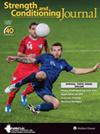使用不同强度的阻力训练对肌肉肥大收益的影响——一个叙述性的回顾
IF 3
4区 医学
Q2 SPORT SCIENCES
引用次数: 0
摘要
阻力训练或力量训练已经成为最流行的运动形式之一,因为它是唯一能够同时提高身体素质和增加肌肉质量的方法。在训练的变量中,强度和体积之间的关系已被广泛研究,以增强运动诱导的肌肉肥大。对于许多人来说,机械应力被视为一个更相关的因素,因为高负荷会促进更大的机械张力,而高强度通常用于增加肌肉质量。然而,有证据表明,通过较低强度和增加训练量的训练,安全性更高,效果相似。因此,这篇叙述性综述旨在搜索当前文献中使用不同训练负荷促进肌肉肥大的证据。在PubMed、Google Scholar和Scielo数据库中进行了广泛的非系统文献综述。可以得出结论,在所有组中,高强度和低强度的使用促进了相似的肌肉肥大结果,导致人们相信,与同心衰竭的密切努力相比,使用低强度的安全性和依从性更高。参见视频1 -视频摘要- http://links.lww.com/SCJ/A403。本文章由计算机程序翻译,如有差异,请以英文原文为准。
Effect of Using Different Intensities in Resistance Training for Muscle Hypertrophy Gains—A Narrative Review
ABSTRACT Resistance training or strength training has become one of the most popular forms of exercise, because it is the only method capable of improving physical fitness and increasing muscle mass simultaneously. Among the variables of training, the relationship between intensity and volume has been extensively addressed to enhance exercise-induced muscular hypertrophy. For many, mechanical stress is seen as a factor of greater relevance and, because high loads promote greater mechanical tension and high intensities are traditionally used to increase muscle mass. However, evidence has shown greater safety and similar results through training based on lower intensities and increased training volume. Thus, this narrative review aimed to search the current literature for evidence on using different training loads to promote muscle hypertrophy. An extensive nonsystematic literature review was conducted in the PubMed, Google Scholar and Scielo databases. It was possible to conclude that the use of high and low intensity promotes similar results in muscle hypertrophy in all groups, leading to the belief that there is greater safety and adherence to the use of lower intensities compared with close effort to concentric failure. See Video 1—Video Abstract—http://links.lww.com/SCJ/A403.
求助全文
通过发布文献求助,成功后即可免费获取论文全文。
去求助
来源期刊

Strength and Conditioning Journal
社会科学-运动科学
CiteScore
4.70
自引率
8.00%
发文量
49
审稿时长
6-12 weeks
期刊介绍:
Strength and Conditioning Journal is the professional journal for strength coaches, personal trainers, physical therapists, athletic trainers, and other health professionals working in the strength and conditioning field. The journal’s mission is to publish articles that report both the practical applications of research findings and the knowledge gained by experienced professionals.
 求助内容:
求助内容: 应助结果提醒方式:
应助结果提醒方式:


